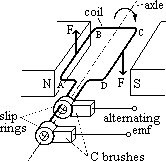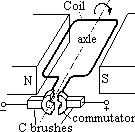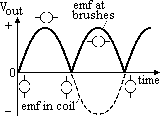ELECTROMAGNETIC INDUCTION
mag flux through a small plane surface, φ = flux density normal to surface × area of surface

φ = BA [φ:weber, Wb]
B = 1 T, A = 1m2 > φ = 1 weber, Wb
1 Wb = 1 Tm2 > 1 T = 1 Wb/m2
area of coil not perpendicular to B-field: φ = BAcosθ [θ = angle bet normal & B-field]
coil w/ N turns, area A, mag flux, φ
total flux = flux linkage = Nφ (since all same φ)
Φ = Nφ
electromagnetic induction: production of I elec from magnetism
-involves changing B-field in /near a circuit
-induced V produced > can cause I if circuit is complete
I induced when mag moved in/out of coil

I induced depends on;
-strength of B-field
-# of turns of wire
-rel speed of cutting B-field lines
-area of coil
I increases w/ -rel speed, -stronger magnet, -# of turns
reverse wire movement > reverse I

Movement of wire:
1 > 2, 3 > 4: no I induced as B-field lines not 'cut' by conductor
5 > 6: I induced as B-field lines 'cut' by conductor
Lenz's law: induced I always flows in a direction at to oppose the change causing it
-an example of conservation of energy as WD to prod elec energy

clockwise I induced > N pole > repel magnet
anti-clockwise I induced > S pole > attract magnet
pole induced s.t. it opposes change producing I > WD to prod elec energy
Fleming's right-hand rule: gives direction of induced current of straight conductor moving at right angles to a B-field


wire moved across a perpendicular magnetic field
I induced > there will be a F on cond since it is a I-carrying cond in a B-field
F on conductor to left = BIl
F opposes movement of cond (ie movement causing induced I) > work done to prod elec energy
Faraday's Law: size of induced voltage I a cond is equal to rate of change of mag flux linking the coil/circuit (equal if correct SI units, if not it is only proportional)
ζ = -dφ/dt [-ve sign: for Lenz's law]
φ = BA


dφ/dt = B × area change per second = Blv > |ζ| = Blv
Applications of electromagnetic induction
AC generator
-main components = coil & magnet

coil rotated about axis
=> wire cuts magnetic field
=> induced I exists
horizontal: Vout = max (F perpendicular to field)
BC, AD no induced V as they are parallel to field

total flux cut by all turns of coil
Φ = NBAcosθ
[N = # of turns, θ = angle bet normal to coil & field]
θ = ωt = 2ωft

DC generator
-same as AC gen but use commutator (2 ½ rings of Cu insulated from each other)
-commutator reverses connection every ½ cycle so that current is unidirectional


Comparison of AC & DC usage
AC easier to generate than DC
alternating emf: easily stepped up/down
AC just as effective as DC for heating purposes (heating effect irrespective of current direction) and lighting
small motors: AC can be used
large motors: only DC
DC only: electrochemical processes, charging batteries
Back to 'A' level notes index
Back to notes index












